Construction and career
Chikuma was laid down at Hitachi Zosen Corporation Osaka Shipyard on 14 February 1991 and launched on 25 January 1992. She was commissioned on 24 February 1993 and deployed to Maizuru. [2]
The Australian Navy destroyer HMAS Perth and the frigate HMAS Canberra, which docked at Maizuru from October 29 to November 3, 1993, hosted the escort ship JS Abukuma.
On June 13, 2000, she was transferred to the 25th Escort Corps of the Ominato District Force in place of the training ship JS Akigumo, and her homeport was transferred from Maizuru to Mutsu.
From May 11 to May 15, 2012, she and the French Navy information gathering ship Dupuy de Lôme participated in exercises at Hakodate Port.
At around 15:40 on November 22, 2018, she was firing her high-performance Phalanx CIWS cannon on the deck about 130 km off Kumejima, Okinawa Prefecture, heavy seas caused the misfire of 21 rounds. The still live ammunition was dropped into the sea, and there were no injuries. [3]

JDS Teruzuki (DD-162) was a Japanese Akizuki-class destroyer. The vessel was laid down in 1958 and served as a front line warship with the Japan Maritime Self-Defense Force until 1986, and as an auxiliary until 1993.

The Japan Maritime Self-Defense Force, abbreviated JMSDF, also simply known as the Japanese Navy, is the maritime warfare branch of the Japan Self-Defense Forces, tasked with the naval defense of Japan. The JMSDF was formed following the dissolution of the Imperial Japanese Navy (IJN) after World War II. The JMSDF has a fleet of 154 ships, 346 aircraft and 50,800 personnel.

JDS Amatsukaze (DDG-163) was a guided missile destroyer (DDG) of the Japan Maritime Self-Defense Force (JMSDF), and the only ship of her class. She was the first Japanese surface combatant equipped with surface-to-air missiles.

JS Haruna (DDH-141) was the lead ship of the Haruna-class helicopter destroyer of the Japanese Maritime Self Defense Force.

JS Mineyuki (DD-124) was a Hatsuyuki-class destroyer of the Japanese Maritime Self-Defense Force.

JDS Yukikaze (DD-102) was the second ship of Harukaze-class destroyers, and the second destroyer of the Japanese Maritime Self Defense Force to be built in Japan since the end of World War II.
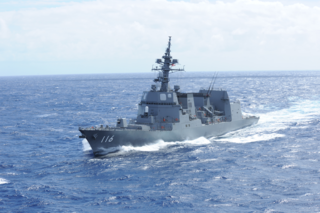
JS Teruzuki (DD-116) is the second ship of Akizuki-class destroyers. She was commissioned on 7 March 2013.

JS Ikazuchi (DD-107) is the seventh ship of the Murasame-class destroyers in service with the Japan Maritime Self-Defense Force. She was commissioned on 14 March 2001.
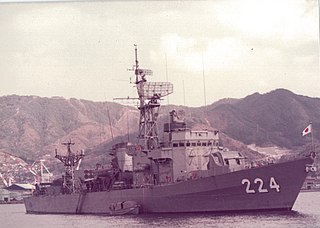
JDS Kumano (DE-224) was the tenth ship of the Chikugo-class destroyer escorts of Japan Maritime Self-Defense Force.
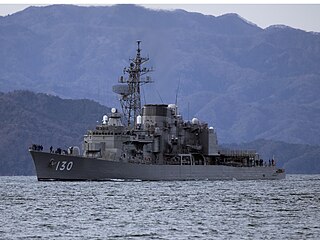
JS Matsuyuki (DD-130) is a Hatsuyuki-class destroyer of the Japan Maritime Self-Defense Force.

JS Hamayuki (DD-126) was a Hatsuyuki-class destroyer of the Japanese Maritime Self-Defense Force.

JS Abukuma (DE-229) is the lead ship of the Abukuma-class destroyer escorts. She was commissioned on 12 December 1989.

JS Jintsū (DE-230) is the second ship of the Abukuma-class destroyer escorts. She was commissioned on 28 February 1990.

JS Ōyodo (DE-231) is the third ship of the Abukuma-class destroyer escorts. She was commissioned on 23 January 1991.
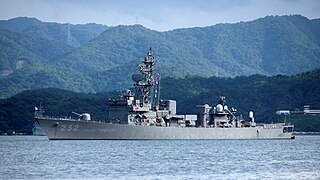
JS Sendai (DE-232) is the fourth ship of the Abukuma-class destroyer escorts. She was commissioned on 26 January 1990.
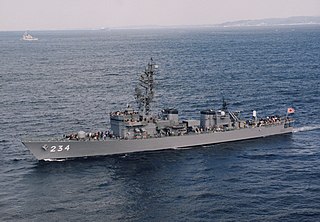
JS Tone (DE-234) is the sixth ship of the Abukuma-class destroyer escorts. She was commissioned on 8 February 1993.

JDS Chitose (DE-220) was the sixth ship of the Chikugo-class destroyer escorts of Japan Maritime Self-Defense Force.

JDS Yoshino (DE-223) was the tenth ship of the Chikugo-class destroyer escorts of Japan Maritime Self-Defense Force.

The Fleet Escort Force is the main force of the Self Defense Fleet of the Japan Maritime Self-Defense Force, and played a central role in the Maritime Self-Defense Force, which mainly consists of escort vessels and various other ships. Together with the Fleet Submarine Force, Mine Warfare Force, and Fleet Air Force, it is responsible for Japan's maritime defense.
The Sasebo Naval Base, also simply known as the JMSDF Sasebo Naval Base, is a group of ports and land facilities of the Japan Maritime Self-Defense Force (JMSDF), which are scattered in multiple districts of Sasebo City, Kyushu, and where the Sasebo District Force are located.
This page is based on this
Wikipedia article Text is available under the
CC BY-SA 4.0 license; additional terms may apply.
Images, videos and audio are available under their respective licenses.
























